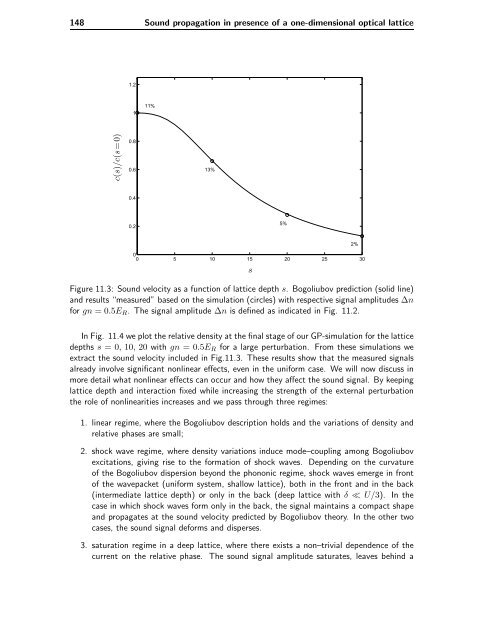Bose-Einstein Condensates in Rotating Traps and Optical ... - BEC
Bose-Einstein Condensates in Rotating Traps and Optical ... - BEC
Bose-Einstein Condensates in Rotating Traps and Optical ... - BEC
You also want an ePaper? Increase the reach of your titles
YUMPU automatically turns print PDFs into web optimized ePapers that Google loves.
148 Sound propagation <strong>in</strong> presence of a one-dimensional optical lattice<br />
c(s)/c(s=0)<br />
1.2<br />
1<br />
0.8<br />
0.6<br />
0.4<br />
0.2<br />
11%<br />
13%<br />
0<br />
0 5 10 15 20 25 30<br />
Figure 11.3: Sound velocity as a function of lattice depth s. Bogoliubov prediction (solid l<strong>in</strong>e)<br />
<strong>and</strong> results “measured” based on the simulation (circles) with respective signal amplitudes ∆n<br />
for gn =0.5ER. The signal amplitude ∆n is def<strong>in</strong>ed as <strong>in</strong>dicated <strong>in</strong> Fig. 11.2.<br />
In Fig. 11.4 we plot the relative density at the f<strong>in</strong>al stage of our GP-simulation for the lattice<br />
depths s =0, 10, 20 with gn =0.5ER for a large perturbation. From these simulations we<br />
extract the sound velocity <strong>in</strong>cluded <strong>in</strong> Fig.11.3. These results show that the measured signals<br />
already <strong>in</strong>volve significant nonl<strong>in</strong>ear effects, even <strong>in</strong> the uniform case. We will now discuss <strong>in</strong><br />
more detail what nonl<strong>in</strong>ear effects can occur <strong>and</strong> how they affect the sound signal. By keep<strong>in</strong>g<br />
lattice depth <strong>and</strong> <strong>in</strong>teraction fixed while <strong>in</strong>creas<strong>in</strong>g the strength of the external perturbation<br />
the role of nonl<strong>in</strong>earities <strong>in</strong>creases <strong>and</strong> we pass through three regimes:<br />
1. l<strong>in</strong>ear regime, where the Bogoliubov description holds <strong>and</strong> the variations of density <strong>and</strong><br />
relative phases are small;<br />
2. shock wave regime, where density variations <strong>in</strong>duce mode–coupl<strong>in</strong>g among Bogoliubov<br />
excitations, giv<strong>in</strong>g rise to the formation of shock waves. Depend<strong>in</strong>g on the curvature<br />
of the Bogoliubov dispersion beyond the phononic regime, shock waves emerge <strong>in</strong> front<br />
of the wavepacket (uniform system, shallow lattice), both <strong>in</strong> the front <strong>and</strong> <strong>in</strong> the back<br />
(<strong>in</strong>termediate lattice depth) or only <strong>in</strong> the back (deep lattice with δ ≪ U/3). In the<br />
case <strong>in</strong> which shock waves form only <strong>in</strong> the back, the signal ma<strong>in</strong>ta<strong>in</strong>s a compact shape<br />
<strong>and</strong> propagates at the sound velocity predicted by Bogoliubov theory. In the other two<br />
cases, the sound signal deforms <strong>and</strong> disperses.<br />
3. saturation regime <strong>in</strong> a deep lattice, where there exists a non–trivial dependence of the<br />
current on the relative phase. The sound signal amplitude saturates, leaves beh<strong>in</strong>d a<br />
s<br />
5%<br />
2%




